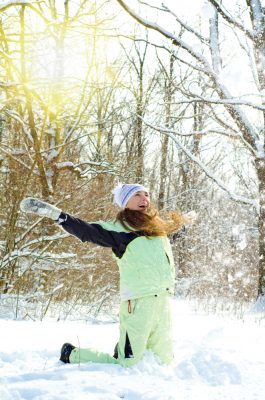Gear, Sports Apparel
Exercising Outside in Cold Weather: How to Stay Safe

Exercising Outside in Cold Weather: How to Stay Safe
Exercising outside is an enjoyable and healthy activity, but can become problematic during the winter months. New difficulties with outdoors exercise arise when the temperatures drop. Chief among these are the dangers to health and well-being inherent in the cold. While it can be tempting to hibernate all winter and abandon physical activity, you’ll be happier and healthier if you keep working out. Awareness of the dangers of cold weather and knowledge of how to protect yourself is what you need.
The risks fall in to two categories: those that stem from the severe weather that can accompany the cold, and those caused or exacerbated by the cold itself. The first category includes extreme weather conditions such as hail, heavy snow, or a lightning storm. Use basic common sense: if a blizzard is forecast to be hitting your area, go running on another day. Similarly, if there is ice on the roads, don’t go out until it is salted or melts in the sun. It’s hard to avoid falling on ice (especially if you are walking or running) and a nasty fall can result in broken bones.
Avoid walking on roads if visibility is bad. Even relatively light snowfall can be deadly if it obscures motorist’s vision. Wear bright colors even in good conditions, since pale clothing will blend you into the snowy background. If there is snow on the ground, put on boots or non-slip shoes. Wear waterproof clothing that will keep wetness out. Your shoes or boots should also be waterproof — leather is a good material to choose. Wear socks that absorb moisture.
Of course, colder weather doesn’t necessitate snowfall or other extreme weather. The cold itself can make exercise outdoors tricky. If you are not adequately protected, you are in danger of frostbite or hypothermia. Frostbite is the partial freezing of body tissue. In severe cold the body naturally directs blood flow to its most important parts, the organs. This leaves the extremities farthest from the heart at risk of frostbite. Pain, numbness, and skin discoloration are the chief signs of the condition. In worst-case scenarios the effected tissue will have to be removed.
Hypothermia is an even more serious condition in which the body’s core temperature drops below 95 °F (98.6 °F is normal). If you are suffering from hypothermia you will shiver severely and experience mental confusion. Hypothermia will be fatal if left untreated, and can cause permanent damage even if a victim does survive.
However, hypothermia and frostbite are extreme dangers that will be avoided if the right preventive measures are taken. They are no reason to eschew outdoors exercise in cold weather. Wear warm enough clothing and follow basic safeguards and you will be fine.
Dress in warm, loose layers (wool is the best material for retaining heat). Multiple layers will function like insulation, trapping warm air in between each item of clothing and keeping out the cold. Try to wear breathable clothing (especially for your outer layer) that will let perspiration escape. The innermost layer should be made of a material that will wick away sweat. Cover up as much exposed skin as possible. If there is no need for the bright clothes mentioned earlier, wear dark clothes since they absorb the most possible heat from the sun.

You should pay particular attention to what you put on your feet, hands, and head, since they are especially vulnerable to the cold. Always wear socks if exercising in the cold. Your socks should be loose so that warm air can be trapped in between your toes. Wearing socks that extend above your ankle will provide more protection. On your hands, wear mittens instead of gloves, since having your fingers touch each other will make them warmer. Your head should always be protected, as an uncovered head can bleed body heat very quickly. Wear a warm hat, preferably one that covers your ears (or use earmuffs). A ski mask also works.
Remember, when it comes to clothing in cold weather, it’s better to be safe than sorry. Too much clothing has never hurt anyone — while too little can be very dangerous. If you do find yourself getting hot as you exercise, simply peel off a layer or two and tie the items around your waist, or take off your hat.
There are a few medical conditions that can make exercising in the cold problematic even if all the normal precautions are taken. Those with high-blood pressure or heart problems can have difficulties because freezing conditions place higher stress on the cardiovascular system, since the body constricts blood vessels (thereby raising blood pressure) in cold weather to keep more blood near the organs. Asthmatics can also suffer in the winter because the air is cold and dry. If you have either of these conditions, be careful to avoid over exertion when exercising outside in the cold.
Exercising outside during the winter brings with it added challenges, but those challenges are far from insurmountable. It is clear that a little common sense, a few precautions, and attention to the risks inherent to winter weather are all that is needed. Don’t let the cold keep you cooped up inside the whole winter. Follow this guide and you will be able to exercise outside throughout the entire season.